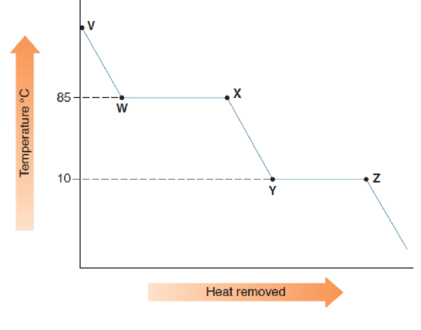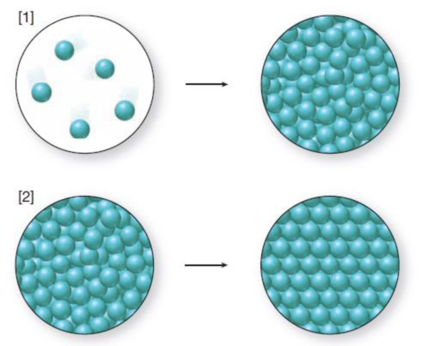
Connect 1-Semester Online Access for Principles of General, Organic & Biochemistry
2nd Edition
ISBN: 9780077633707
Author: Janice Smith
Publisher: Mcgraw-hill Higher Education (us)
expand_more
expand_more
format_list_bulleted
Textbook Question
Chapter 4, Problem 4.31UKC
Consider the cooling curve drawn below.

- a. Which line segment corresponds to the following changes of state?

- b. What is the melting point of the substance?
- c. What is the boiling point of the substance?
Expert Solution & Answer
Want to see the full answer?
Check out a sample textbook solution
Chapter 4 Solutions
Connect 1-Semester Online Access for Principles of General, Organic & Biochemistry
Ch. 4.1 - Prob. 4.1PCh. 4.1 - Prob. 4.2PCh. 4.1 - Prob. 4.3PCh. 4.1 - Prob. 4.4PCh. 4.2 - Prob. 4.5PCh. 4.2 - Prob. 4.6PCh. 4.3 - Prob. 4.7PCh. 4.3 - Prob. 4.8PCh. 4.3 - Prob. 4.9PCh. 4.3 - Prob. 4.10P
Ch. 4.3 - Which of the compounds in each pair has stronger...Ch. 4.4 - Prob. 4.12PCh. 4.4 - Prob. 4.13PCh. 4.5 - A student has two containers one with 10 g of...Ch. 4.5 - Prob. 4.15PCh. 4.5 - How much energy is required to heat 28.0 g of iron...Ch. 4.5 - Prob. 4.17PCh. 4.5 - Prob. 4.18PCh. 4.5 - Prob. 4.19PCh. 4.6 - Prob. 4.20PCh. 4.6 - Prob. 4.21PCh. 4.6 - Label each process as endothermic or exothermic...Ch. 4.6 - Prob. 4.23PCh. 4.7 - Answer the following questions about the graph. a....Ch. 4.7 - Prob. 4.25PCh. 4.7 - If the cooling curve in Figure 4.5 represented a...Ch. 4.7 - How much energy (in calories) is released when...Ch. 4.7 - Prob. 4.28PCh. 4 - What phase change is shown in the accompanying...Ch. 4 - What phase change is shown in the accompanying...Ch. 4 - Consider the cooling curve drawn below. a. Which...Ch. 4 - Which line segments on the cooling curve in...Ch. 4 - Prob. 4.33UKCCh. 4 - Prob. 4.34UKCCh. 4 - Prob. 4.35UKCCh. 4 - Prob. 4.36UKCCh. 4 - Prob. 4.37UKCCh. 4 - Prob. 4.38UKCCh. 4 - Prob. 4.39APCh. 4 - Prob. 4.40APCh. 4 - Prob. 4.41APCh. 4 - Prob. 4.49APCh. 4 - Prob. 4.50APCh. 4 - Prob. 4.54APCh. 4 - Prob. 4.55APCh. 4 - Prob. 4.56APCh. 4 - Prob. 4.57APCh. 4 - Prob. 4.58APCh. 4 - Prob. 4.59APCh. 4 - Prob. 4.60APCh. 4 - Prob. 4.61APCh. 4 - Prob. 4.62APCh. 4 - Prob. 4.63APCh. 4 - Prob. 4.64APCh. 4 - Prob. 4.65APCh. 4 - Prob. 4.66APCh. 4 - Prob. 4.67APCh. 4 - Prob. 4.68APCh. 4 - Prob. 4.69APCh. 4 - Prob. 4.70APCh. 4 - Prob. 4.71APCh. 4 - Prob. 4.72APCh. 4 - Prob. 4.73APCh. 4 - Prob. 4.74APCh. 4 - Prob. 4.75APCh. 4 - Prob. 4.76APCh. 4 - Prob. 4.77APCh. 4 - Prob. 4.78APCh. 4 - Prob. 4.79APCh. 4 - Why does steam form when hot lava falls into the...Ch. 4 - Prob. 4.81APCh. 4 - Prob. 4.82AP
Knowledge Booster
Learn more about
Need a deep-dive on the concept behind this application? Look no further. Learn more about this topic, chemistry and related others by exploring similar questions and additional content below.Similar questions
- Heat is added to boiling water. Explain why the temperature of the boiling water does not change. What does change?arrow_forwardWhat is the relationship between the intermolecular forces in a solid and its melting temperature?arrow_forwardWhat types of liquids typically form amorphous solids?arrow_forward
- Use the heating-cooling curve below to answer the following questions. a. What is the freezing point of the liquid? b. What is the boiling point of the liquid? c. Which is greater, the heat of fusion or the heat of vaporization? Explain each term and explain how the heating-cooling curve above helps you to answer the question.arrow_forwardThe amount of heat required to melt 2 lbs of ice is twice the amount of heat required to melt 1 lb of ice. Is this observation a macroscopic or microscopic description of chemical behavior? Explain your answer.arrow_forwardWhat is U when 1.00 mol of liquid water vaporizes at 100C? The heat of vaporization, Hvap, of water at 100C is 40.66 kJ/mol.arrow_forward
- Some water is placed in a sealed glass container connected to a vacuum pump (a device used to pump gases from a container), and the pump is turned on. The water appears to boil and then freezes. Explain these changes using the phase diagram for water. What would happen to the ice if the vacuum pump was left on indefinitely?arrow_forwardLiquid Freon (CCl2F2) is used as a refrigerant. It is circulated inside the cooling coils of older refrigerators or freezers. As it vaporizes, it absorbs heat. How much heat can be removed by 2.00kg of Freon as it vaporizes inside the coils of a refrigerator? The heat of vaporization of Freon is 38.6cal/g.arrow_forwardThe phase diagram for elemental sulfur is shown in Figure 6.18. Figure 6.18 Phase diagram for elemental sulfur. a How many allotropes are shown? b What is the stable allotrope of sulfur under normal conditions of temperature and pressure? c Describe the changes to sulfur as its temperature is increased from 25C while at 1atm pressure.arrow_forward
arrow_back_ios
arrow_forward_ios
Recommended textbooks for you
 Introductory Chemistry: An Active Learning Approa...ChemistryISBN:9781305079250Author:Mark S. Cracolice, Ed PetersPublisher:Cengage LearningChemistry: Matter and ChangeChemistryISBN:9780078746376Author:Dinah Zike, Laurel Dingrando, Nicholas Hainen, Cheryl WistromPublisher:Glencoe/McGraw-Hill School Pub Co
Introductory Chemistry: An Active Learning Approa...ChemistryISBN:9781305079250Author:Mark S. Cracolice, Ed PetersPublisher:Cengage LearningChemistry: Matter and ChangeChemistryISBN:9780078746376Author:Dinah Zike, Laurel Dingrando, Nicholas Hainen, Cheryl WistromPublisher:Glencoe/McGraw-Hill School Pub Co Chemistry: An Atoms First ApproachChemistryISBN:9781305079243Author:Steven S. Zumdahl, Susan A. ZumdahlPublisher:Cengage Learning
Chemistry: An Atoms First ApproachChemistryISBN:9781305079243Author:Steven S. Zumdahl, Susan A. ZumdahlPublisher:Cengage Learning World of Chemistry, 3rd editionChemistryISBN:9781133109655Author:Steven S. Zumdahl, Susan L. Zumdahl, Donald J. DeCostePublisher:Brooks / Cole / Cengage Learning
World of Chemistry, 3rd editionChemistryISBN:9781133109655Author:Steven S. Zumdahl, Susan L. Zumdahl, Donald J. DeCostePublisher:Brooks / Cole / Cengage Learning EBK A SMALL SCALE APPROACH TO ORGANIC LChemistryISBN:9781305446021Author:LampmanPublisher:CENGAGE LEARNING - CONSIGNMENT
EBK A SMALL SCALE APPROACH TO ORGANIC LChemistryISBN:9781305446021Author:LampmanPublisher:CENGAGE LEARNING - CONSIGNMENT ChemistryChemistryISBN:9781305957404Author:Steven S. Zumdahl, Susan A. Zumdahl, Donald J. DeCostePublisher:Cengage Learning
ChemistryChemistryISBN:9781305957404Author:Steven S. Zumdahl, Susan A. Zumdahl, Donald J. DeCostePublisher:Cengage Learning

Introductory Chemistry: An Active Learning Approa...
Chemistry
ISBN:9781305079250
Author:Mark S. Cracolice, Ed Peters
Publisher:Cengage Learning

Chemistry: Matter and Change
Chemistry
ISBN:9780078746376
Author:Dinah Zike, Laurel Dingrando, Nicholas Hainen, Cheryl Wistrom
Publisher:Glencoe/McGraw-Hill School Pub Co

Chemistry: An Atoms First Approach
Chemistry
ISBN:9781305079243
Author:Steven S. Zumdahl, Susan A. Zumdahl
Publisher:Cengage Learning

World of Chemistry, 3rd edition
Chemistry
ISBN:9781133109655
Author:Steven S. Zumdahl, Susan L. Zumdahl, Donald J. DeCoste
Publisher:Brooks / Cole / Cengage Learning

EBK A SMALL SCALE APPROACH TO ORGANIC L
Chemistry
ISBN:9781305446021
Author:Lampman
Publisher:CENGAGE LEARNING - CONSIGNMENT

Chemistry
Chemistry
ISBN:9781305957404
Author:Steven S. Zumdahl, Susan A. Zumdahl, Donald J. DeCoste
Publisher:Cengage Learning
Viscosity, Cohesive and Adhesive Forces, Surface Tension, and Capillary Action; Author: Professor Dave Explains;https://www.youtube.com/watch?v=P_jQ1B9UwpU;License: Standard YouTube License, CC-BY